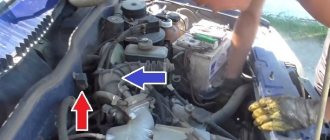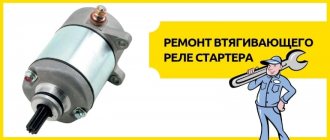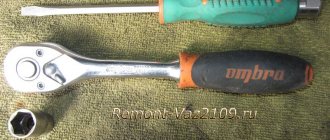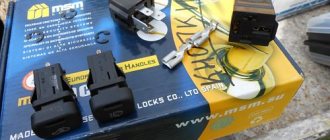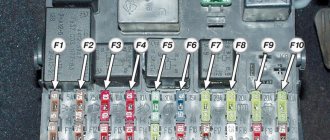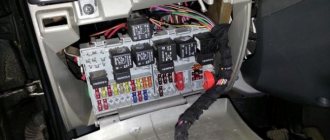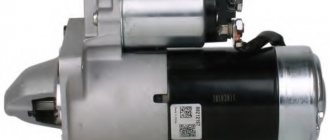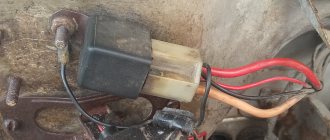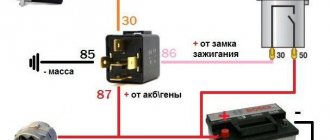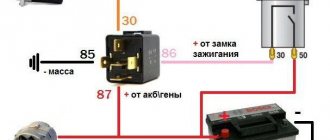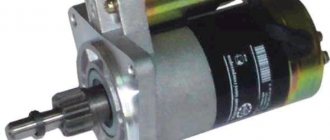It is known that a car cannot drive without a starter. It seems like a simple electric motor, but you can’t do without it. You can start a piston unit with a failed “starting” unit only from a pusher, but only for a trip to a car service specialist.
The reasons for the breakdown of such a critical mechanism are quite obvious. Most diseases can be cured if you repair the starter yourself. We list below the main sources of malfunctions:
- natural wear and tear of electric motor elements;
- water ingress while washing the car engine;
- improper operation of the unit, for example, long periods of operation of the electric motor after starting the engine;
- short circuits.
Do-it-yourself partial repair of the starter usually saves you from all this. That is, it is not at all necessary to buy a new unit entirely. Next, we will look at which specific elements fail, and how to repair the starter with your own hands.
Let us first note that according to the symptoms when turning the ignition key, it is necessary to distinguish between the types of malfunctions of the starting electric motor. If, for example, after turning the key you hear a clicking or crackling noise, then the problem is in the retractor cylinder. The latter can be completely replaced.
How to deal with the VAZ unit
First, let's look at how to repair the starter with your own hands on VAZ cars. First, let's take the very first of the cars in this line.
To repair a VAZ 2101 with your own hands, we will use the tools listed below:
- set of wrenches;
- flathead and Phillips screwdrivers;
- sandpaper;
- heads.
So, let's start work by opening the hood.
- Disconnect the terminals from the battery.
- We dismantle the air filter housing with the filter element.
- Unscrew the three nuts securing the electric motor to the motor.
- We disconnect the wires after taking photographs of the connections.
- We remove the defective device.
- Perhaps the so-called “pants” - the exhaust pipe - will interfere with this, then you will have to unscrew the four bolts and “lower the pants”.
- We separate the retractor cylinder from the dismantled element by disconnecting the wire and unscrewing three screws. We inspect it and, if necessary, replace it completely.
- After unscrewing the bolts, remove the motor casing.
- After unscrewing the two bolts, remove the cover.
- Separate the windings from the brush holder plates and remove the insulating tube.
- Separate the cover from the collector side.
- Use a screwdriver to remove the motor brushes. We measure them and replace them if necessary.
- We disassemble the drive of the defective assembly unit. To do this, undo the cotter pin, then remove the drive lever, disengage the drive from the clutch, and then remove it.
- We inspect the windings of the electric motor.
- If necessary, we press it out, and then replace the bushings of the assembly.
- We clean elements with soot or plaque. We replace failed parts with new spare parts.
- We carry out assembly and installation in the opposite direction.
Note that do-it-yourself starter repair for a VAZ 2106 is carried out according to similar instructions.
Also find out where the fuel filter is located on the Hyundai Solaris and the structure of the fuel pump.
If we discuss the problem that interests us regarding front-wheel drive VAZs, then it is enough to simply consider what differences there are from the given instructions. The tools used here are the same.
However, for example, when repairing a VAZ 2109 starter yourself, you do not need to disconnect the exhaust pipe during removal from the car. Further manipulations are carried out exactly as described above.
Naturally, repairing a similar VAZ 2108 starter with your own hands is done according to a similar scenario. When repairing a VAZ 2110 starter with your own hands, it is easier to immediately remove the solenoid relay while dismantling the unit from the car by unscrewing the corresponding nuts.
However, in case of repairing the starter of a VAZ 2115 with your own hands, the electric motor can be dismantled immediately along with the retractor cylinder.
By the way, it is not necessary to replace this completely assembled cylinder if it breaks. You can also repair the starter retractor relay yourself. To do this, you need to disassemble it, inspect the retractor winding, return spring, and replace failed parts. As for domestic cars, UAZ repairs can be performed according to the given instructions from VAZ.
How are things going with other popular cars?
Now let’s touch on two more truly popular cars. Let's talk about sorting through the starting element on Oka, as well as Nexia.
To repair the starter at Oka with our own hands, we will need:
- set of wrenches;
- screwdrivers.
We start by dismantling the unit; it is located under the thermostat of the cooling system.
- In this car, the starting device is attached to only two points; to remove it, you need to unscrew the bolt on one side and the nut on the other. But first we disconnect the wires, both from the battery, from the retractor cylinder and from the connecting block.
- We unscrew the two nuts, and then remove the traction relay.
- Unscrew and remove the cover casing from the collector side.
- We dismantle the brush springs, locking, and adjusting washers.
- Separate the cover from the body where the collector is.
- We remove the brushes, then measure them; when they are worn out, they need to be replaced.
- Having unfastened the cotter pin, we dismantle the lever axis.
- Remove the cover from the drive side.
- We remove the drive lever, then take out the anchor.
- We inspect the windings of the electric motor.
- We dismantle the drive coupling and inspect its condition. This clutch is also called bendix. In case of any defects in the clutch, it is easy to repair the Bendix of any starter with your own hands. You just need to replace the broken elements.
- We take out the bendix spring and replace it if necessary.
These are some simple manipulations.
It must be said that in such a small car, such as the Tavria, the mounting of our treasured electric motor is also made at two points, and its design is similar. Therefore, Tavria does its own repairs in the same way.
Well, with Oka and Tavria it’s somehow easier, but if the starting unit of another people’s car breaks down, will it be more difficult? Let's see. To repair the starter of a Daewoo Nexia with your own hands, you need to prepare:
- set of wrenches;
- screwdrivers.
- To dismantle the unit from the car - here, like all rather large cars, there are three fastenings - unscrew the nuts and disconnect the wires. You need to know that a “ground” wire is attached to the upper bolt that secures the electric motor to the piston unit.
- We immediately check the drive gear; it should only rotate unidirectionally.
- We disassemble and sort out the assembly in the same way as in previous cases.
- We also disconnect the solenoid relay.
- We remove the cover from the collector side, as well as from the drive side.
- We dismantle and then, if necessary, replace the brushes.
- We take out the anchor and study the windings.
- If necessary, we press it out, and then replace the bushings of the assembly.
- We do the assembly in reverse order.
Apparently, there are few difficulties here.
The same can be said about repairing a starter, for example, an Audi 80 with your own hands. There you need to act, practically repeating the above points.
Price and necessity of the procedure
However, not everyone decides to repair the starter with their own hands. For some, turning to a car service center may seem like a much more convenient option. For such car enthusiasts, we have compiled a table with prices for the described operation.
Starter connection diagram 29.3708 for VAZ 2108, 2109, 21099 cars: 3 comments
In this article, we will be much more interested in the second relay, which is responsible for the operation of the starter, namely the retractor. Also look at how much charge the battery has. And now he saves 35 rubles a year on gasoline! Replace the core. Register on the site 2.
We conducted a little investigation and came to the following conclusions, yes, from the factory on VAZ cars, a starter relay was installed. If the starter does not turn off, then the relay is missing. Most often, such a start indicates wear of the teeth on the Bendix gear or the teeth of the engine flywheel.
To understand why a starter solenoid relay is needed, let’s look at the engine’s operation schematically. Other possible schemes are no different from the one described. We conducted a little investigation and came to the following conclusions, yes, from the factory on VAZ cars, a starter relay was installed. The problem is not constant, this can happen once a week, maybe every other day. VAZ starter relay wiring diagram. SOLVING THE PROBLEM WITH THE IGNITION SWITCH VAZ 2110 2111 2112
See also: Manual for an estimator for electrical installation work
Replacing the solenoid relay on the VAZ 2110 starter yourself
Starter and retractor relay VAZ 2110
If the car suddenly stops starting, there are no characteristic sounds before starting the engine, or a strange “humming” noise appears, then the starter solenoid relay may be damaged. Naturally, the device can sometimes work normally without showing signs of breakdown, but at the most inopportune moments the car has to be started from the pusher. In this situation, only replacing the retractor on the VAZ 2110 starter will change everything for the better. Symptoms of the malfunction are different, for example, the appearance of clicks at the relay, lack of cranking of the starter, lack of signs of life when turning the ignition key, etc. It is worth noting that replacing the VAZ 2110 retractor starter can be done with your own hands.
Selecting a part for a VAZ-2110
Often the entire starter assembly is replaced, but we recommend not doing this. The pull-out relay is much cheaper than the entire kit.
The choice of a new relay should be approached with the utmost seriousness, since the quality of the part will determine how long it will serve the owner.
Most VAZ-2110 are equipped with a solenoid relay manufactured by Bosch, with catalog number 2339303293 . The cost of the part is about 2000 rubles.
Analogs
In addition to the proposed version of the original part, there are quite a lot of analogues that can be installed on a car. So, many car enthusiasts do just that. Let's look at what the automotive spare parts market offers the owner of a 2110:
- Cargo 131143 – the cost is 1200 rubles. High quality for little money.
Cargo.
- Maxgear 10-0166 is a cheap substitute with average quality and a price of 1000 rubles.
- Zm 573 – high quality, but also high cost. Price about 2100 rub.
- Protech IA9154 – average quality. Cost – 2500 rubles.
- Cargo 333572 is a high-quality and expensive part. The average price is 3000 rubles.
Solenoid relay
The VAZ 2110 starter solenoid relay is designed to remotely turn on the electric starter motor. They ensure the clutch of the bendix (see Replacing the bendix on the VAZ 2110 starter on your own) with the flywheel crown. This element structurally consists of: a returning, contact and magnetic system, including two coils - a holding coil, connected to the control terminal and going to the housing, and a retracting coil, connected by the control element.
This is interesting: Repair scheme for Kedr Auto 10A
VAZ 2110 starter solenoid relay
The pipe where the armature is located is a core, inside of which there is a copper winding (the end and beginning of the winding are attached with terminals, one side is connected to the electric motor and the control contact, the other is connected to the control terminal and goes to the housing).
VAZ 2110 retractor clicks and the starter does not turn
The movement of the armature in the core is carried out due to the electromagnetic field, and when the voltage disappears, the armature in the core goes to its initial state. When powered, a magnetic field appears, causing the armature to retract the return springs. When the car engine starts, the voltage begins to disappear, the spring presses on the armature and it returns to its initial position, the contacts open, the Bendix disengages. If the solenoid relay breaks down and before replacing it, you should first make sure that the problem lies in the starter.
Note. It is necessary to exclude the following malfunctions in the car: the presence of scale, battery discharge, traces of oxidation on the terminals, damage to the wiring, loose contacts. The car may not start for these reasons.
How to repair a starter
To carry out repairs, you will need to disassemble the device completely, literally piece by piece. At the same time, the traction relay, which drives the starter on the VAZ-2110, is generally checked and serviced separately. New models are not subject to repair; they are enclosed in a solid body. But if you look at its cost, it turns out that repairs will cost a small amount. When you disassemble the starter, the first thing you will need to do is install new brushes. If the old ones are less than 12 mm long, then they have already become unusable.
Cleaning the slats is also impossible without it. First, clean the gaps between adjacent contacts from dirt, then arm yourself with polishing paste and rub the metal surface. Upon completion of this procedure, rinse with solvent. You should not use sandpaper, as it will make the surface of the lamellas abrasive, resulting in rapid wear of the starter brushes. And at the last stage you replace both bushings. One is located in the rear cover, and the second is located in the clutch housing. When making repairs, replace both, otherwise the rotor alignment will be disrupted. And there will be no contact between the battery negative and the rotor. As a result, you will get that the VAZ-2110 starter simply does not turn.
Examination
VAZ 2110 retractor starter
To check the functionality of the starter, you will need a battery and two wires:
- First the starter is removed;
- Using the first wire, the output of the solenoid relay is connected to the positive terminal of the battery;
- The second cable is connected to the negative terminal with the starter ground;
Note: if there is a click, this indicates that the Bendix mechanism is working. It is important that the click is sharp and fast. If the sound seems sluggish and drawn out, then something is wrong inside the mechanism, for example, the pin contacts have burned out.
VAZ 2110 does not turn the starter, the retractor clicks
If, after the inspection, there is a suspicion that the starter requires repair, you should immediately go to purchase a new spare part. If the starter is not removable, then the entire solenoid relay must be replaced. If it is collapsible, then:
- To repair the solenoid relay, unscrew the screws on the relay housing cover.
Note. In some cases, it is necessary to unsolder the ends of the winding; they can be an obstacle to removing the cover.
- After removing the cover, the power contacts are checked; in many cases they cause damage to the device.
Note. If possible, replace old contacts with new ones. If the contact is not badly damaged, the burnt surface is removed using fine-grained sandpaper.
- After this, the structure is assembled in the reverse order.
The retractor relay is installed under the hood and is located on the starter. When buying a new one, you need to take the non-working item with you and ask the store for a similar one - in this case, mistakes are excluded. All manufacturers make their own markings on the solenoid relay. The device is secured with three screws.
VAZ 2110 remove starter retractor
Checking status
Before changing the relay, make sure that the problem with starting the engine is related to this component.
To do this, consider two situations that indicate its malfunction.
| Situation | Your actions |
| The relay makes clicks, but the armature does not spin | If there are clicks from the relay, check the condition of the armature. To do this, the terminals of the retractor relay are bridged with a large screwdriver or a piece of welding cable to the terminals at the ends. Taking a thin wire or a screwdriver can easily burn the terminals. When the armature is working, after closing the terminals, the armature will spin, which can be determined by the sound. Consequently, the solenoid relay itself has failed and requires repair. |
| The relay is completely silent | Even if there is silence after closing the terminals, the problem should be looked for in the starter. The relay no longer plays any role here. |
Having discovered that the relay has served its purpose, it must be replaced or repaired, if possible.
Replacement
VAZ 2110 starter retractor
To replace the solenoid relay on a VAZ 2110, you will need the appropriate tools. Before starting work, it is imperative to disconnect the battery mass, which is marked with a minus sign, from the battery. To do this you will need a 10mm wrench. After removing the contact, you need to find the starter. It is located at the bottom of the engine compartment, between the engine block and the cooling system. Only after this can you begin to dismantle the device.
VAZ 2110 starter retractor
- Two wires are connected to the solenoid relay; it is necessary to disconnect the red wire that runs from the relay to the male contact.
- Unscrew two nuts on the back of the relay; this is done using a “13” wrench.
- Using a flathead screwdriver, disconnect the cord from the front of the relay retainer.
- After releasing the relay, it must be carefully removed.
Note. When performing this procedure, you need to make sure that the core is inside and the spring located in the relay does not fall out. This is a very complex procedure in the process of replacing the solenoid relay.
To install a new retractor, repeat the steps in reverse order. Due to the fact that we left the old core, the new relay is mounted without it, only with a new spring. So:
- Armed with a flat-head screwdriver, you need to screw the wires in front of the relay.
- Connect to the wires and tighten the nuts using a “13” wrench.
After installing the relay, you need to tightly tighten the nuts that connect the power wire and are attached to the “male”. That's all, the machine is ready to go. To replace this element yourself, you will need only three tools, a video review and a photo instruction. To perform this procedure with your own hands, you will have to spend about 16 minutes of time and save about 500 rubles in your wallet, which you would have to pay for repairs in car workshops, where the price of these services is constantly rising.
Typical breakdowns
Now let’s figure out how to check the starter solenoid relay on a VAZ 2110. It must be carefully inspected after dismantling.
This unit is characterized by certain breakdowns, which we will talk about.
- The fastening is loose or the nuts responsible for fastening the wire end are completely loose. Everything is simple here, as you understand. You just need to tighten the fasteners.
- Oxidation has formed on the windings, connections or wiring. If everything is not too serious, you can simply clean the contacts. In case of serious oxidation, it is better to replace them with new ones.
- The power supply circuit has breaks. Again, you don’t need to come up with anything fancy, just replace the chain.
- The armature exhibits idle operation or slow operation. Just replace the armature and that's it, problem solved.
- Check the short circuit of the turns of the two windings using an ohmmeter.
How does the VAZ-2110 starter relay work?
When the current stops flowing through the coil, the armature is free in the core. The solenoid relay consists of a magnet with two windings, an armature, contacts and a return spring. The magnet consists of two coils: one retracting, the other holding. The first is connected to the control terminal and the electric motor, the second is connected to the control terminal and goes to the housing.
When the control contact is energized, magnetic induction is induced in the coil, creating a magnetic field that causes the armature to compress the return spring. At the same time, it rotates the bendix, which connects the battery to the starter. The retracting winding is energized “+” when the contacts are closed, the current stops flowing through the coil, but the armature remains inside under the influence of the field of the holding coil.
When the engine starts and the power is turned off, the return spring moves the armature to its original place - the contacts are open, the bendix is disengaged.
What does a car need a traction relay for?
The starter solenoid (or traction) relay is a fairly important device. At the dawn of the automotive industry, the role of this unit was played by a long handle and the driver himself, who, by inserting it into the hole in the flywheel, accelerated the engine. Later, cars acquired starters with retractor relays, which are designed to provide initial force to the gear that drives the motor shafts.
Starter traction relay
In the designs of most cars (as in “classic” VAZ models), the retractor relay is a small unit mounted directly on the starter housing itself. His tasks are the following:
- moving the bendix gear to engage the flywheel teeth and returning it to its original position after the engine starts running;
- energy distribution between the starter drive and the electromagnet;
- synchronous operation of the starter during engine starting.
The starters installed on the VAZ-2106 and 2107 starters are actually the same. Regarding the solenoid relay, we can say that it has not undergone any significant changes. But there is one more detail with the same name, which is considered the difference between these two models. This is the starter activation relay: on early VAZ models it is not there at all, but in 2107 it appears.
Relay for turning on the VAZ-2107 mechanism
Before this innovation, control from the ignition switch went directly to the solenoid relay.
It is worth saying a few words about this mechanism. The starter activation relay is located some distance from the starting mechanism itself, so you should look for it by wires. Naturally, with each new release of VAZ, its location changed. But when it first appeared in 2107, the starter relay was located on the right mudguard in the engine compartment. It is easy to remove and replace with a 10mm wrench. But the traction relay still does more work and fails much more often, so let’s talk about it in more detail.
How to install the VAZ-2110 starter solenoid relay?
- We remove the terminals from the battery, put the gearbox in neutral, otherwise when the starter is turned on, the car may start moving.
- We purchase a four-contact relay with open contacts, three wires with “mothers” with which we will connect the relay to the retractor starter and plus to ground, of which: two 25 cm each - on one “mother” at both ends, one with a terminal at one end and a ring for an M8 bolt on the other, also 5 cm with a terminal and a ring for M6.
- We connect the relay with the retractor as follows:
- Using one nut to ground, we tighten the wires, with the second we secure the relay, plus it will come from the power stud:
Replacing the starter relay
- Clicking noises when turning the ignition key, but without cranking the starter itself
- no reaction at all when trying to start the engine
Of course, there are times when the relay can be repaired, for example, when nickels burn. In this case, you can simply clean them and everything will work again. But in most cases you have to change the retractor completely. Fortunately, the price of this part is not so high, so you won’t have to spend much.
It is worth noting that to perform this repair you will need the following tool:
- Socket head 13
- Ratchet handle
- Phillips blade screwdriver
Of course, it is most convenient to replace the retractor after removing the starter. After this, you must first unscrew the nut securing the wire terminal, as shown in the photo below:
And disconnect it:
Now turn the starter over and unscrew the two bolts securing the solenoid relay:
Now you can remove the relay by moving it to the side:
If the core remains engaged, then you need to disconnect it with a simple movement of your hand:
Now you can replace the solenoid relay, since everything is ready for this. The price of a new part may be about 500 rubles. Installation is carried out in reverse order.
Signs and causes of relay failure
If the relay is broken, the following signs will tell you about it:
- when you try to start the engine with the key, it does not start, or starts only after two or three attempts;
- There is a buzzing sound after the engine starts. This means that the starter rotates at higher speeds, although it should no longer be.
If at least one of these signs is observed, then this is a reason to be wary. The relay may soon break. There are several reasons why this happens:
- one of the windings, or both, were burned or broken at once;
- deformation of the return spring inside the mechanism;
- a short circuit has occurred inside the part on one of the windings;
- The surface area of the contact plates has decreased, or they have completely burned out.
Understanding the reasons why the relay fails, repairs will take less time, because It’s immediately clear where to look for the problem.
We recommend: Do-it-yourself repair of shock absorber struts
VAZ 2110 - replacing the starter retractor relay
The most common reason why the car starter does not work is a malfunction of the solenoid relay. You can drive your car and not suspect anything, but at one fine moment the car will stop starting, you will need to call friends and start it with a push. To be armed and know the features of the starter, today we will tell you how to replace the solenoid relay on a VAZ 2110 with your own hands.
This is interesting: Video on how to assemble a starter on a trimmer
Symptoms of a malfunction can be different, for example, the relay clicks, but the starter itself does not turn, or it happens that when you turn the ignition key there are no signs of life. To quickly troubleshoot a problem, you need to have the following tools available:
- flat screwdriver; - head 8; - ratchet.
Let us remind you that in the previous article we told you how to replace ball joints on a VAZ 2110 with your own hands. Considering the quality of parts today, replacement is required almost every 5-6 months, so I recommend bookmarking the instructions.
Replacing the starter solenoid relay with your own hands
1. You can unscrew and replace the relay without removing the starter from the car, but it is better to do all this with the device removed from the car. When this is done, you need to unscrew the nut securing the terminal to the stud, as is clearly shown in the photo above.
2. Then carefully remove the terminal and move it and the wire a little to the side.
3. Now on the back side of the starter you need to unscrew two bolts using a regular flat-head screwdriver. All this is clearly demonstrated in the picture.
4. Now you can remove the relay without experiencing any difficulties. gently pulling it back. If it does not come off, then you need to lift it slightly so that it disengages from the anchor.
5. If it was removed separately from the spring, then it can be removed later along with the anchor.
How to replace the starter solenoid relay on a VAZ 2107 One of the main causes of starter failure on a VAZ 2107 is the failure of the solenoid relay. The first symptoms of a malfunction are when you hear clicks when you turn the ignition key, but the starter never starts to turn. Today we will look at
Replacing the solenoid relay on a VAZ 2115 The solenoid relay in the VAZ 2115 starter is the most vulnerable point, so when malfunctions occur in the starter, you should immediately pay attention to this detail. Symptoms of a malfunctioning solenoid relay can vary, ranging from:
Typical malfunctions of the VAZ solenoid relay, their diagnosis and elimination
The solenoid relay has a very simple design, therefore it is highly reliable and durable. However, this unit is often subjected to high loads, and the starter relay installed on it operates with very high currents (up to several hundred amperes), so from time to time characteristic malfunctions occur in the solenoid relay.
Most often you may encounter the following malfunctions of the solenoid relay:
- Burning of the power contacts of the starter relay on the side of the contact disk;
- Break in the pull-in or retaining windings;
- Short circuit in the pull-in or holding windings;
- Deformation of the return spring;
- Other mechanical damage or destruction of individual relay parts.
How does the VAZ-2110 starter relay work?
When the current stops flowing through the coil, the armature is free in the core. The solenoid relay consists of a magnet with two windings, an armature, contacts and a return spring. The magnet consists of two coils: one retracting, the other holding. The first is connected to the control terminal and the electric motor, the second is connected to the control terminal and goes to the housing.
When the control contact is energized, magnetic induction is induced in the coil, creating a magnetic field that causes the armature to compress the return spring. At the same time, it rotates the bendix, which connects the battery to the starter. The retracting winding is energized “+” when the contacts are closed, the current stops flowing through the coil, but the armature remains inside under the influence of the field of the holding coil.
When the engine starts and the power is turned off, the return spring moves the armature to its original place - the contacts are open, the bendix is disengaged.
How to install the VAZ-2110 starter solenoid relay?
- We remove the terminals from the battery, put the gearbox in neutral, otherwise when the starter is turned on, the car may start moving.
- We purchase a four-contact relay with open contacts, three wires with “mothers” with which we will connect the relay to the retractor starter and plus to ground, of which: two 25 cm each - on one “mother” at both ends, one with a terminal at one end and a ring for an M8 bolt on the other, also 5 cm with a terminal and a ring for M6.
- We connect the relay with the retractor as follows:
- Using one nut to ground, we tighten the wires, with the second we secure the relay, plus it will come from the power stud:
DIY VAZ starter repair
It is important to know!
Every motorist should have a universal device for removing scratches on a car of any color. The effect is visible within 10 minutes, and the action of RENUMAX will pleasantly surprise you with its simplicity and effectiveness. Read more >>>
The service manual contains detailed instructions for replacing the starter, and you will also find a diagram and design of the starter in it). But as a rule, any similar process is not without difficulties, so let’s figure out how to repair a starter using a specific example:
Removing the starter retaining ring
To remove it, I had to pry it off with a flat screwdriver. After replacing the starter Bendix, I had difficulty reassembling the rings in the reverse position, but something turned out to be wrong. It turned out that the restrictive ring has a slot for the retaining ring and should be put on on the opposite side of the bendix.
Repair of starter retractor relay
The starter solenoid relay (the little thing to which the wires attach, also called the traction relay). The principle of its operation is as follows: 12v is supplied from the ignition switch to the coils in a metal case. They retract the armature of the retractor relay (a metal sinker with its end hooked to the tail of the bendix). With one end he drives out the bendix, with the other he presses the lever inside the relay, which closes the “+” contact coming from the battery. The plus is transferred to the brushes that make the armature spin. The gears transmit torque to the extended bendix, thus the flywheel rotates.
When removed carefully, you can easily break it by pulling the contacts from the winding. After unscrewing, you need to heat the contacts with a soldering iron and remove the plastic from the metal case. There is no particular point in disassembling it. You can't get into the coils; they seem to be filled with plastic. Therefore, in this case, it is recommended to strip the copper contacts from the lever, and the contacts from the bolts. You can also check with a tester for the presence of contacts.
Checking the starter solenoid relay:
- Usually “+” is applied to the flat contact from the ignition switch, and “-” to the housing.
- Alternatively, it’s different: “+” is a flat contact and minus is on the bolt to the starter (more precisely, on the brushes installed in a larger housing). There should be a click (don't forget to put the anchor inside).
Thus, by checking it is possible to determine the cause of the starter malfunction. For example, poor contact can be corrected by placing tin on the washer holding the contact bolt.
The price of the starter retractor relay is about 350 rubles.
Disassembling the stator with armature
Monitoring the technical condition of the mechanism
The driver must know how to check the starter solenoid relay himself. Attention should be paid to the appearance of a characteristic sound: when the key is turned, a click appears in the ignition switch. Further attempts to start the car end in a series of clicks and jerks. Signs such as these indicate the need for the following check:
- bridge the 2 copper contacts located on the back cover of the relay;
- the movement that appears will indicate a malfunction of the retractor mechanism;
- at the time of testing, it is necessary to exercise maximum caution, because the solenoid relays rotate at high speed;
- An additional method of control will be to connect the positive connector of the retractor mechanism to the “+” of the battery;
- the second wire connects the ground of the starter and the battery;
- If the retracting mechanisms are working properly, then at the moment the circuit closes, a sharp click is heard.
This is interesting: Test drive Suzuki Wagon R
Further actions of the car owner depend on the nature of the detected malfunction. If the device runs too fast or slow, we are talking about mechanical wear of its individual elements. Retractor mechanisms often fail due to a short circuit. Charred contacts are expressed in a series of clicks, complemented by slow operation of the mechanism.
Planned or emergency replacement of the starter relay is associated with monitoring the technical condition of the starter itself. For preventive purposes, the bolts securing its rear wall are removed. If necessary, the device is freed from accumulated traces of contamination. At the next stage, the Bendix fork and brushes 2112 are checked for physical wear. If any are found, replacement is made.
There is no point in postponing this procedure until later. With further operation there is a high risk of damaging the traction relay. After this, all elements are returned to their place. The rear cover of the starter is closed, and the immediate repair of the starter solenoid relay begins.
